Stonehenge
31/12/11 04:51
In 1978 Susan and I had the opportunity to visit Stonhenge in England. It is undeniably a very mysterious and interesting place. Archaeologists have dated the construction somewhere between 3000 and 2000 BC. Standing in the shadow of the massive stones, contemplating the human effort that must have been required to move and put them into place.
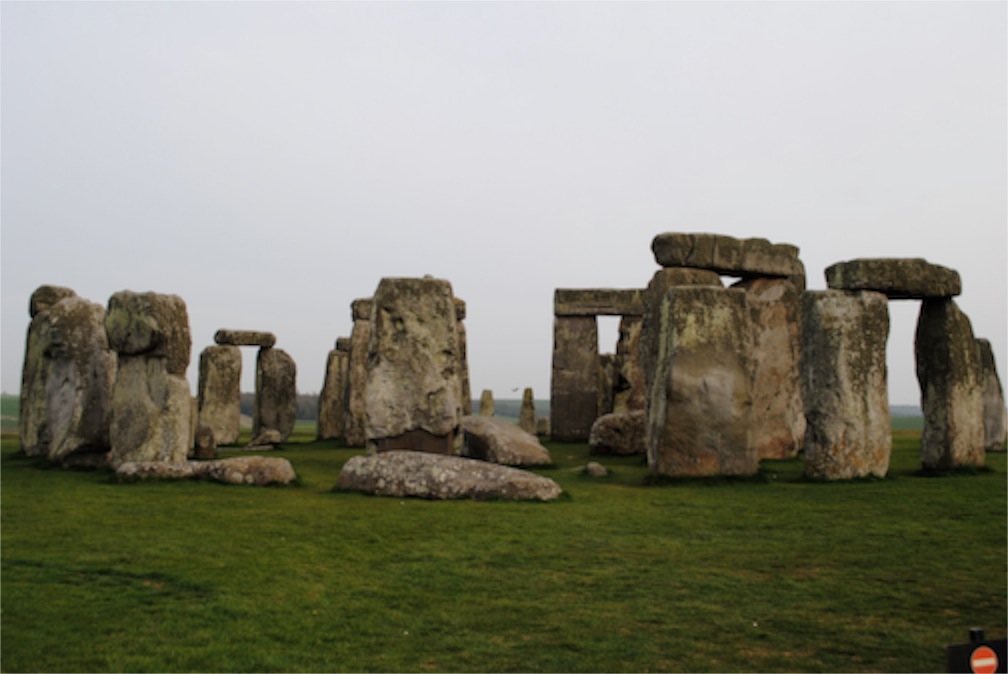
It was a once-in-a-lifetime experience. Even if we return someday, it won’t be the same. These days, tourists cannot wander at will among the stones. Docents and guards are required to keep the crowds at a respectable distance. I have never particularly felt the need to go back. My memories are very strong. When our daughter visited Stonehenge a few years ago, looking at her pictures reminded us of the power of the experience. I know almost nothing of the beliefs of the prehistoric people who constructed the site. My own faith wasn’t changed by the visit to Stonehenge, but my appreciation of a faith that is different from my own was increased.
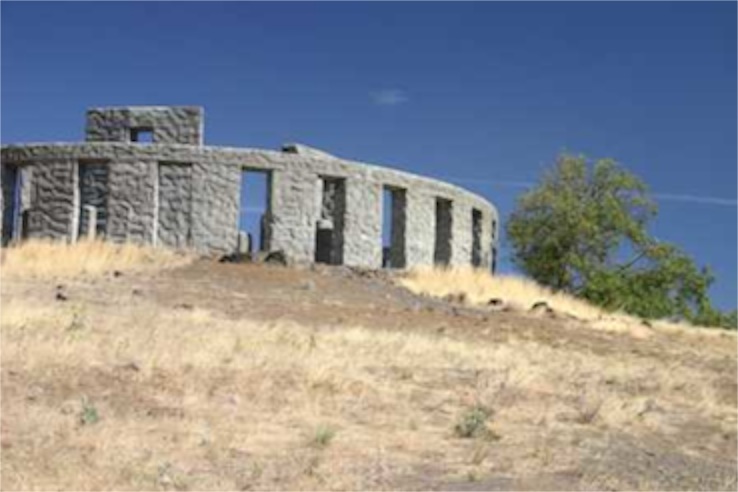
Some years later, Susan and I paid a visit to Maryhill, high on the bluffs of the Columbia Gorge in Washington. The railroad man and developer Samuel Hill, in his later years, decided to build a Quaker community alongside the Columbia River. He named it after his daughter Mary and he had built, as a centerpiece of this community a full-size replica of Stonehenge. He dedicated his structure as a memorial to the soldiers and sailors who fought in World War I. Instead of trying to reproduce what is currently found in England, Hill built a structure out of reinforced concrete designed to look like Stonehenge looked before the stones weathered and began to crumble with time. It was a major effort. Construction began in 1918 and wasn’t finished until 1930, just a year before Hill died. He was buried on the hillside just below his version of Stonehenge. Unlike the English version, which is set in the middle of agricultural lands, the Washington Stonehenge replica sits high on the hill with a fantastic view of the Columbia River Gorge, the Sam Hill memorial bridge and, in the distance, Mt. Hood.
My education about Stonehenge, it seems, was just beginning.
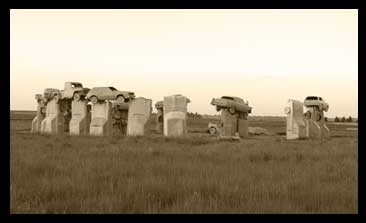
All that was before I moved to South Dakota and took the trip south to the ranch land just outside of Alliance, Nebraska, to visit Carhenge. An incredible creation of cars buried in the prairie in roughly the shape of Stonehenge, Carhenge has been named the No. 2 Wackiest Attraction in the United States. Having seen it, I’m thinking “only in America.” There are plenty of places in the world where so much effort would not have been expended to create such a strange sight. I recommend that all of my friends visit Carhenge. I don’t think you can see it without having a smile on your face.
Ah, but it doesn’t stop there.
For Christmas this year, I received a book from my daughter and son-in-law. Being perceptive students of my reading tastes, they found a perfect gift book for me: Weird Missouri: Your Travel Guide to Missouri’s Local Legends and Best Kept Secrets. Reading that book has been a treat this week, and I have been keeping a list of things in our children’s adopted state that I want to be sure to see.
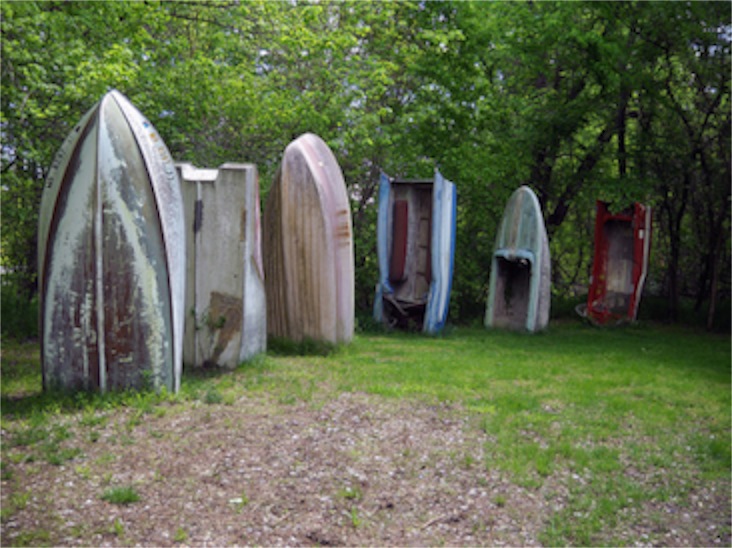
High on the list is Boathenge. Yes, you’ve got it! Someone has taken a backhoe and a stack of old boats and started to set those babies in the ground in a circle. I’m pretty sure this one qualifies as “Only in America.” It might even qualify as “Only a Redneck.” I’m planning to make time to see it. Given its location on the Katy Trail between Rocheport and Jefferson City and the closeness of the trail to the Missouri River, the ideal way to visit would be to paddle in and out - an excursion just right for someone with my interests.
As they say in infomercials, “But wait! There is more!
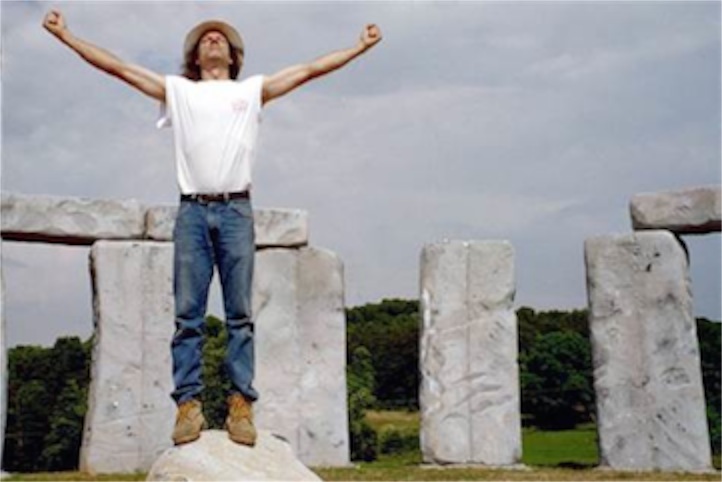
Mark Cline built a replica of Stonehenge near Natural Bridge, Virginia, including the altar stone, where it is believed human sacrifices were made. This version is known as Foamhenge because it is made entirely out of giant blocks of styrofoam.
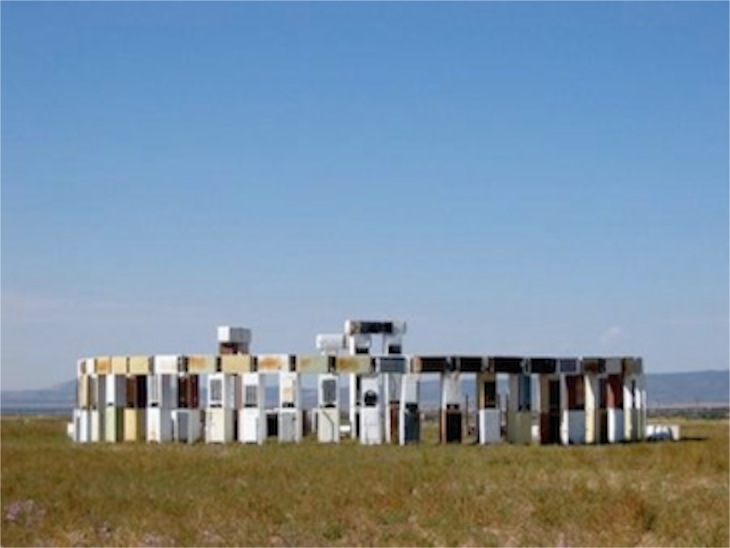
In 2003, near Santa Fe, New Mexico, artist Adam Jonas Horowitz and the Primordial Soup Company constructed Fridgehenge - or is it Stonefridge? Anyway they found a creative use for more than 100 old refrigerators. And they have built a monument to the creativity and sense of humor of our fellow citizens in this wonderful country.
Then there’s America’s Stonehenge outside of Salem, New Hampshire. Although it doesn’t look at all like the one in England, it is a 4000 year old human-made archeological site.
Given enough time I could check out the Georgia Guidestones, a large granite monument in Ebert County, Georgia, or Stonehenge II in Kerrville Texas, the 60% scale replica made of plaster-covered steel, or the subdivision named Stone Henge in Athens Georgia, or Stonehenge Jr. in Wichita, Kansas. Given its location in Missouri, home of boathenge, we might one day actually visit the University of Missouri at Rolla, where there is a 1/2 scale replica of stonehenge built to showcase the stone carving capabilities of the University’s High Pressure Water Jet Laboratory.
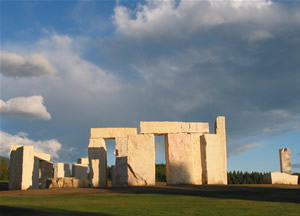
One that we may never see except in pictures is Stonehenge Montana. Tucked up in the northwest corner of Montana near the Canada and Idaho borders, a wealthy resident of the private Crystal Lakes Resort had his own replica made. Some consider the structure, built by Anderson Masonry, Inc. to be nearly perfect. Pictures of the construction are featured on the web site of the company. Although we love to travel in that part of Montana and there is some paddling I’d like to do in the region, we won’t likely ever receive an invitation to see this replica that is on private land and not open to the public.
But it got me to thinking. I’ve got about a half acre. There is the problem of neighborhood covenants, but so far no one has built a microwavehenge, or a dryerhenge, or dead computerhenge, or bicyclehenge . . .
The possibilities are endless!
Happy New Year!

It was a once-in-a-lifetime experience. Even if we return someday, it won’t be the same. These days, tourists cannot wander at will among the stones. Docents and guards are required to keep the crowds at a respectable distance. I have never particularly felt the need to go back. My memories are very strong. When our daughter visited Stonehenge a few years ago, looking at her pictures reminded us of the power of the experience. I know almost nothing of the beliefs of the prehistoric people who constructed the site. My own faith wasn’t changed by the visit to Stonehenge, but my appreciation of a faith that is different from my own was increased.

Some years later, Susan and I paid a visit to Maryhill, high on the bluffs of the Columbia Gorge in Washington. The railroad man and developer Samuel Hill, in his later years, decided to build a Quaker community alongside the Columbia River. He named it after his daughter Mary and he had built, as a centerpiece of this community a full-size replica of Stonehenge. He dedicated his structure as a memorial to the soldiers and sailors who fought in World War I. Instead of trying to reproduce what is currently found in England, Hill built a structure out of reinforced concrete designed to look like Stonehenge looked before the stones weathered and began to crumble with time. It was a major effort. Construction began in 1918 and wasn’t finished until 1930, just a year before Hill died. He was buried on the hillside just below his version of Stonehenge. Unlike the English version, which is set in the middle of agricultural lands, the Washington Stonehenge replica sits high on the hill with a fantastic view of the Columbia River Gorge, the Sam Hill memorial bridge and, in the distance, Mt. Hood.
My education about Stonehenge, it seems, was just beginning.

All that was before I moved to South Dakota and took the trip south to the ranch land just outside of Alliance, Nebraska, to visit Carhenge. An incredible creation of cars buried in the prairie in roughly the shape of Stonehenge, Carhenge has been named the No. 2 Wackiest Attraction in the United States. Having seen it, I’m thinking “only in America.” There are plenty of places in the world where so much effort would not have been expended to create such a strange sight. I recommend that all of my friends visit Carhenge. I don’t think you can see it without having a smile on your face.
Ah, but it doesn’t stop there.
For Christmas this year, I received a book from my daughter and son-in-law. Being perceptive students of my reading tastes, they found a perfect gift book for me: Weird Missouri: Your Travel Guide to Missouri’s Local Legends and Best Kept Secrets. Reading that book has been a treat this week, and I have been keeping a list of things in our children’s adopted state that I want to be sure to see.

High on the list is Boathenge. Yes, you’ve got it! Someone has taken a backhoe and a stack of old boats and started to set those babies in the ground in a circle. I’m pretty sure this one qualifies as “Only in America.” It might even qualify as “Only a Redneck.” I’m planning to make time to see it. Given its location on the Katy Trail between Rocheport and Jefferson City and the closeness of the trail to the Missouri River, the ideal way to visit would be to paddle in and out - an excursion just right for someone with my interests.
As they say in infomercials, “But wait! There is more!

Mark Cline built a replica of Stonehenge near Natural Bridge, Virginia, including the altar stone, where it is believed human sacrifices were made. This version is known as Foamhenge because it is made entirely out of giant blocks of styrofoam.

In 2003, near Santa Fe, New Mexico, artist Adam Jonas Horowitz and the Primordial Soup Company constructed Fridgehenge - or is it Stonefridge? Anyway they found a creative use for more than 100 old refrigerators. And they have built a monument to the creativity and sense of humor of our fellow citizens in this wonderful country.
Then there’s America’s Stonehenge outside of Salem, New Hampshire. Although it doesn’t look at all like the one in England, it is a 4000 year old human-made archeological site.
Given enough time I could check out the Georgia Guidestones, a large granite monument in Ebert County, Georgia, or Stonehenge II in Kerrville Texas, the 60% scale replica made of plaster-covered steel, or the subdivision named Stone Henge in Athens Georgia, or Stonehenge Jr. in Wichita, Kansas. Given its location in Missouri, home of boathenge, we might one day actually visit the University of Missouri at Rolla, where there is a 1/2 scale replica of stonehenge built to showcase the stone carving capabilities of the University’s High Pressure Water Jet Laboratory.

One that we may never see except in pictures is Stonehenge Montana. Tucked up in the northwest corner of Montana near the Canada and Idaho borders, a wealthy resident of the private Crystal Lakes Resort had his own replica made. Some consider the structure, built by Anderson Masonry, Inc. to be nearly perfect. Pictures of the construction are featured on the web site of the company. Although we love to travel in that part of Montana and there is some paddling I’d like to do in the region, we won’t likely ever receive an invitation to see this replica that is on private land and not open to the public.
But it got me to thinking. I’ve got about a half acre. There is the problem of neighborhood covenants, but so far no one has built a microwavehenge, or a dryerhenge, or dead computerhenge, or bicyclehenge . . .
The possibilities are endless!
Happy New Year!
Copyright © 2011 by Ted Huffman. I wrote this. If you want to copy it, please ask for permission. thuffman53@mac.com. If you want to share it with a friend, please direct your friend to my web site.
Snow Church
30/12/11 05:31
Mitterfirmiansreut is not one of the better known destinations in the world, though I imagine that it would be a wonderful place to visit. Located in Germany in the border triangle of Germany, the Czech Republic and Austria, the Bavarian community is home to many different outdoor sports. Skiing is very popular because of the dependability of the snow and the variety of terrain. There are ski-away rentals with cross country and downhill trails right at the door. Ice skating, tobogganing and winter hiking are also popular attractions in the area.
In the summer, there are lots of well-marked hiking trails in the Bavarian National Forest. The area is known as a place to go to recover from illness and promote general health.
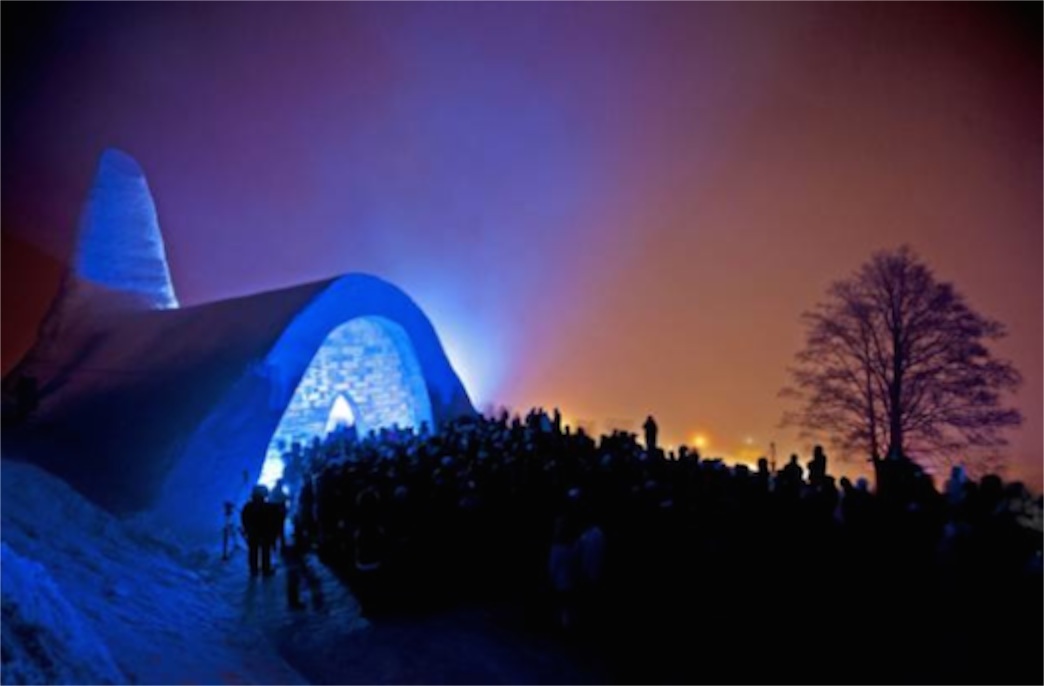
This winter there is something special to see. The church at Mitterfirmiansreut is more than 65 feet long and has a dramatic tower at the chancel end of the building. It is also built entirely of snow and ice. The structure was bathed in blue light as it opened Wednesday evening with a blessing from Dean Kajetan Steinbeisser.
The first snow church at Mitterfirmiansereut was constructed in 1911. The people built it as a provocation - they were trying to get church officials to support the construction and staffing of a church for their community, instead of expecting villagers to worship in the neighboring village of Mauth. During the winter of 1911 the snow was so deep that travel between the two communities was nearly impossible. Believers gathered together and built a snow church because they had no church of their own.
Maybe you have to spend several winters in an isolated mountain location to understand their actions.
A century later, the snow church attracts visitors from around the world and provides an boost to the local activity. Visitors rent rooms, purchase meals in area restaurants and often take in some of the hiking, skiing and health resort options of the area.
The photos that are on the Internet of the church are beautiful and they got me to thinking that there might be some advantages to a snow church. You would never have to worry about remodeling as you get to build a new church each year. There are no problems with the boiler, as heating the building would cause structural problems. Worshippers learn to bundle up against the cold. There are no worries about bathrooms. People use facilities elsewhere before or after coming to the church. And I am guessing that the lack of heat and facilities discourages long sermons and long meetings.
On the other hand there has to be a continual process of planning and construction, with the need for a new church every year.
Churches can get bogged down by their buildings. Church buildings are wonderful places. I have worked in churches for all of my life. The churches that are most familiar to me are filled with memories of special events and significant times of worship. The buildings are consecrated by prayers, but more so by the people who come to the church for baptisms, weddings, funerals and other times of worship to mark the most important moments of their lives.
But buildings are not the mission of the church - the institutions we build are attempts to participate in the on-going work of peace and justice to which we are called by the Gospel. Disciples don’t need buildings in order to be faithful. The buildings are an institutional expression of the gathered church. And buildings, being expensive, can divert attention away from the mission and ministry of the church. I know. I have spend more than a small amount of my life raising funds for remodeling and maintaining church buildings.
In the coming years, our church buildings will need to become much more efficient. We will need to remodel and re-fit our buildings with features that decrease the amount of energy we use. This process has already begun in our church with the addition of insulation and changing the type of light bulbs we use. In the year to come there will be replacement of exit lighting and installation of a new hot water system. Those projects are small, however, in comparison with additional projects that will be needed in years to come. If we do not invest now, the costs of electricity and natural gas will consume all of the funds of our church. It doesn’t take much of an expert to see the ways in which increased energy costs decrease the amount of money for mission and ministry in many congregations.
I’m not advocating getting rid of our buildings, though I know that there can be faithful churches who do not have buildings. And I don’t really want to be the pastor of a snow church that melts every spring.
But I know that every congregation will be challenged by changes that are coming in our world and that we will need to learn to think differently about our buildings and our priorities as we seek to be faithful in the years to come.
In the summer, there are lots of well-marked hiking trails in the Bavarian National Forest. The area is known as a place to go to recover from illness and promote general health.

Photo by Lukas Barth/Associated Press
This winter there is something special to see. The church at Mitterfirmiansreut is more than 65 feet long and has a dramatic tower at the chancel end of the building. It is also built entirely of snow and ice. The structure was bathed in blue light as it opened Wednesday evening with a blessing from Dean Kajetan Steinbeisser.
The first snow church at Mitterfirmiansereut was constructed in 1911. The people built it as a provocation - they were trying to get church officials to support the construction and staffing of a church for their community, instead of expecting villagers to worship in the neighboring village of Mauth. During the winter of 1911 the snow was so deep that travel between the two communities was nearly impossible. Believers gathered together and built a snow church because they had no church of their own.
Maybe you have to spend several winters in an isolated mountain location to understand their actions.
A century later, the snow church attracts visitors from around the world and provides an boost to the local activity. Visitors rent rooms, purchase meals in area restaurants and often take in some of the hiking, skiing and health resort options of the area.
The photos that are on the Internet of the church are beautiful and they got me to thinking that there might be some advantages to a snow church. You would never have to worry about remodeling as you get to build a new church each year. There are no problems with the boiler, as heating the building would cause structural problems. Worshippers learn to bundle up against the cold. There are no worries about bathrooms. People use facilities elsewhere before or after coming to the church. And I am guessing that the lack of heat and facilities discourages long sermons and long meetings.
On the other hand there has to be a continual process of planning and construction, with the need for a new church every year.
Churches can get bogged down by their buildings. Church buildings are wonderful places. I have worked in churches for all of my life. The churches that are most familiar to me are filled with memories of special events and significant times of worship. The buildings are consecrated by prayers, but more so by the people who come to the church for baptisms, weddings, funerals and other times of worship to mark the most important moments of their lives.
But buildings are not the mission of the church - the institutions we build are attempts to participate in the on-going work of peace and justice to which we are called by the Gospel. Disciples don’t need buildings in order to be faithful. The buildings are an institutional expression of the gathered church. And buildings, being expensive, can divert attention away from the mission and ministry of the church. I know. I have spend more than a small amount of my life raising funds for remodeling and maintaining church buildings.
In the coming years, our church buildings will need to become much more efficient. We will need to remodel and re-fit our buildings with features that decrease the amount of energy we use. This process has already begun in our church with the addition of insulation and changing the type of light bulbs we use. In the year to come there will be replacement of exit lighting and installation of a new hot water system. Those projects are small, however, in comparison with additional projects that will be needed in years to come. If we do not invest now, the costs of electricity and natural gas will consume all of the funds of our church. It doesn’t take much of an expert to see the ways in which increased energy costs decrease the amount of money for mission and ministry in many congregations.
I’m not advocating getting rid of our buildings, though I know that there can be faithful churches who do not have buildings. And I don’t really want to be the pastor of a snow church that melts every spring.
But I know that every congregation will be challenged by changes that are coming in our world and that we will need to learn to think differently about our buildings and our priorities as we seek to be faithful in the years to come.
Copyright © 2011 by Ted Huffman. I wrote this. If you want to copy it, please ask for permission. thuffman53@mac.com. If you want to share it with a friend, please direct your friend to my web site.
Journey of a 2x4
29/12/11 05:19
British Columbia, in western Canada, is a major exporter of soft wood. B.C. lumber production is far beyond the consumption rate in the relatively lightly-populated province. Traditionally, the largest market for B.C. lumber is the United States, though there has been a small dip in exports to the United States due to somewhat smaller than usual home construction numbers in the midst of the recession. The number two and three destinations for Canadian lumber are China and Japan. China passed Japan in consumption for the first time in 2009, but prior to that year, Japan was the clear number two importer. Sales of B.C. lumber in Japan continue to be strong despite the rapidly growing Chines market. In 2008, B.C. exported $719 million worth of lumber to Japan.
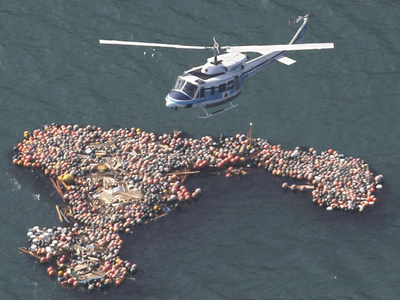
The use of the term “2x4” in the title of today’s blog isn’t quite accurate, since Canadian sawmills have been producing boards to metric dimensions for many years as well as sizing the boards to dimensions in inches for use in Canada and the United States. Nonetheless, a lot of boards come out of BC sawmills, are loaded onto ships and taken to Japan. It is a significant journey for the boards to make - over 4,900 miles. In Japan, the lumber is used for construction of homes, shops, and other buildings.
Now there are quite a few boards heading back to British Columbia.
Shortly after the March 11 earthquake and tsunami in Japan, observers began to notice floats of debris from the events in the Pacific Ocean. As one might expect the debris is quite spread out and traveling at different rates depending on ocean currents. However, some items of debris have begun to wash up on the shores of British Columbia and Washington. Floats from fishing boats occasionally wash on the shores of Washington, but there have been more than usual. The mayor of Tofiino, on Vancouver Island, reports that residents have recovered a larger than normal amount of debris from the community’s beaches. Among the first items of debris have been plastic water bottles, some with japanese letters clearly visible, clothing items, including socks, and, yes a few pieces of lumber with Japanese export stamps on the boards - showing that they had been originally milled in Canada, exported to Japan and now are returning with the first of the debris from the tsunami.
That’s quite a journey for a piece of lumber!
Experts say that this is just the first of a massive amount of debris that will eventually wash up on the shores of Northwestern United States and Canada. Experts say the main debris float is about 483 km northwest of the Midway Islands. The bulk of the debris may take until 2014 to start arriving. Some experts have reported that the main debris field floating in the Pacific covers an area the size of California. That is going to be a lot of flotsam that will need to be cleaned up and already there are some jurisdictional disputes brewing in Canada over who is going to pay for the clean up. As yet authorities do not know how much, if any, of the debris will be toxic or hazardous.
The massive flotsam field is yet another reminder of the devastating tragedy that struck Japan. The magnitude 9.0 earthquake left as many as 21,000 people dead. The tsunami also swamped the Fukushima nuclear power plant. There have been fears that some of the floating debris could be contaminated by radioactive material, though there is no evidence of such in any of the debris arriving on the shores so far.
Almost everything washing up on the shores of British Columbia has Japanese writing on it. However, that may not mean it is debris from the earthquake and tsunami. Even before the catastrophic events, some waste items made the trip from Japan to the Pacific northwest. corks, water bottles and shampoo bottles are occasionally found by fishermen and others. Fishing floats are also common items to wash up on the shores. However, many US and Canadian fishing vessels use gear that was manufactured in Japan, so Japanese writing on fishing gear does not necessarily mean it has floated all the way from Japan.
We live in a world that is interconnected. Events that occur thousands of miles away have an impact on the lives we live. As the debris arrives in the Pacific Northwest it is impossible to ignore the enormous human tragedy that is connected with these floating items. A sock washing up on the beach may have once belonged to one of the victims of the tragedy. A board may have been part of a home that has been totally destroyed.
Coastal residents can expect to be picking up items for years to come. Some areas will require massive, organized clean up responses. And each piece of debris represents a shattered dream and a lives forever changed by the massive tragedy. Cleaning up is one of the ways of working through the grief of such an enormous loss.
A simple thing like a board might be witness to an incredible amount of history, though it cannot report all of its adventures. Perhaps the board came from one of the trees cut in the early years of the great northwestern pine bark beetle infestation. Areas of British Columbia were cut in patchwork patterns in an attempt to slow the infestation. The harvested lumber was milled and much of it exported. Then the board switched continents. Wood fibre that grew from sunlight and rain that fell on Canada was forming the structure of shops and homes in Japan. In an instant it was swept away and became a part of an island of debris floating in the Pacific Ocean. Now it returns to the continent from which it came.
What stories they could tell, if the boards possessed memory and the ability to speak! What a story we can infer from their presence on the beaches as they arrive!
We are more closely connected than we know with people living in distant locations.

The use of the term “2x4” in the title of today’s blog isn’t quite accurate, since Canadian sawmills have been producing boards to metric dimensions for many years as well as sizing the boards to dimensions in inches for use in Canada and the United States. Nonetheless, a lot of boards come out of BC sawmills, are loaded onto ships and taken to Japan. It is a significant journey for the boards to make - over 4,900 miles. In Japan, the lumber is used for construction of homes, shops, and other buildings.
Now there are quite a few boards heading back to British Columbia.
Shortly after the March 11 earthquake and tsunami in Japan, observers began to notice floats of debris from the events in the Pacific Ocean. As one might expect the debris is quite spread out and traveling at different rates depending on ocean currents. However, some items of debris have begun to wash up on the shores of British Columbia and Washington. Floats from fishing boats occasionally wash on the shores of Washington, but there have been more than usual. The mayor of Tofiino, on Vancouver Island, reports that residents have recovered a larger than normal amount of debris from the community’s beaches. Among the first items of debris have been plastic water bottles, some with japanese letters clearly visible, clothing items, including socks, and, yes a few pieces of lumber with Japanese export stamps on the boards - showing that they had been originally milled in Canada, exported to Japan and now are returning with the first of the debris from the tsunami.
That’s quite a journey for a piece of lumber!
Experts say that this is just the first of a massive amount of debris that will eventually wash up on the shores of Northwestern United States and Canada. Experts say the main debris float is about 483 km northwest of the Midway Islands. The bulk of the debris may take until 2014 to start arriving. Some experts have reported that the main debris field floating in the Pacific covers an area the size of California. That is going to be a lot of flotsam that will need to be cleaned up and already there are some jurisdictional disputes brewing in Canada over who is going to pay for the clean up. As yet authorities do not know how much, if any, of the debris will be toxic or hazardous.
The massive flotsam field is yet another reminder of the devastating tragedy that struck Japan. The magnitude 9.0 earthquake left as many as 21,000 people dead. The tsunami also swamped the Fukushima nuclear power plant. There have been fears that some of the floating debris could be contaminated by radioactive material, though there is no evidence of such in any of the debris arriving on the shores so far.
Almost everything washing up on the shores of British Columbia has Japanese writing on it. However, that may not mean it is debris from the earthquake and tsunami. Even before the catastrophic events, some waste items made the trip from Japan to the Pacific northwest. corks, water bottles and shampoo bottles are occasionally found by fishermen and others. Fishing floats are also common items to wash up on the shores. However, many US and Canadian fishing vessels use gear that was manufactured in Japan, so Japanese writing on fishing gear does not necessarily mean it has floated all the way from Japan.
We live in a world that is interconnected. Events that occur thousands of miles away have an impact on the lives we live. As the debris arrives in the Pacific Northwest it is impossible to ignore the enormous human tragedy that is connected with these floating items. A sock washing up on the beach may have once belonged to one of the victims of the tragedy. A board may have been part of a home that has been totally destroyed.
Coastal residents can expect to be picking up items for years to come. Some areas will require massive, organized clean up responses. And each piece of debris represents a shattered dream and a lives forever changed by the massive tragedy. Cleaning up is one of the ways of working through the grief of such an enormous loss.
A simple thing like a board might be witness to an incredible amount of history, though it cannot report all of its adventures. Perhaps the board came from one of the trees cut in the early years of the great northwestern pine bark beetle infestation. Areas of British Columbia were cut in patchwork patterns in an attempt to slow the infestation. The harvested lumber was milled and much of it exported. Then the board switched continents. Wood fibre that grew from sunlight and rain that fell on Canada was forming the structure of shops and homes in Japan. In an instant it was swept away and became a part of an island of debris floating in the Pacific Ocean. Now it returns to the continent from which it came.
What stories they could tell, if the boards possessed memory and the ability to speak! What a story we can infer from their presence on the beaches as they arrive!
We are more closely connected than we know with people living in distant locations.
Copyright © 2011 by Ted Huffman. I wrote this. If you want to copy it, please ask for permission. thuffman53@mac.com. If you want to share it with a friend, please direct your friend to my web site.
My Montana Church
28/12/11 04:57
People develop intense loyalties to locations. I am no different. I grew up in Montana and I had a wonderful childhood. I moved away from Montana to attend seminary. There is no ATS accredited theological seminary in Montana. I fully expected when I went away to seminary that I would accept a call to a congregation in Montana upon my graduation and return to the state to live the rest of my life. As is often true, things didn’t work out the way I had imagined and I have never returned to Montana to live. Our first call was to two churches in North Dakota. We served there happily for seven years. We were then called to serve a congregation in Boise, Idaho, where we lived and worked for ten years. Then, in 1995, we were called to serve here in South Dakota, where we have remained since.
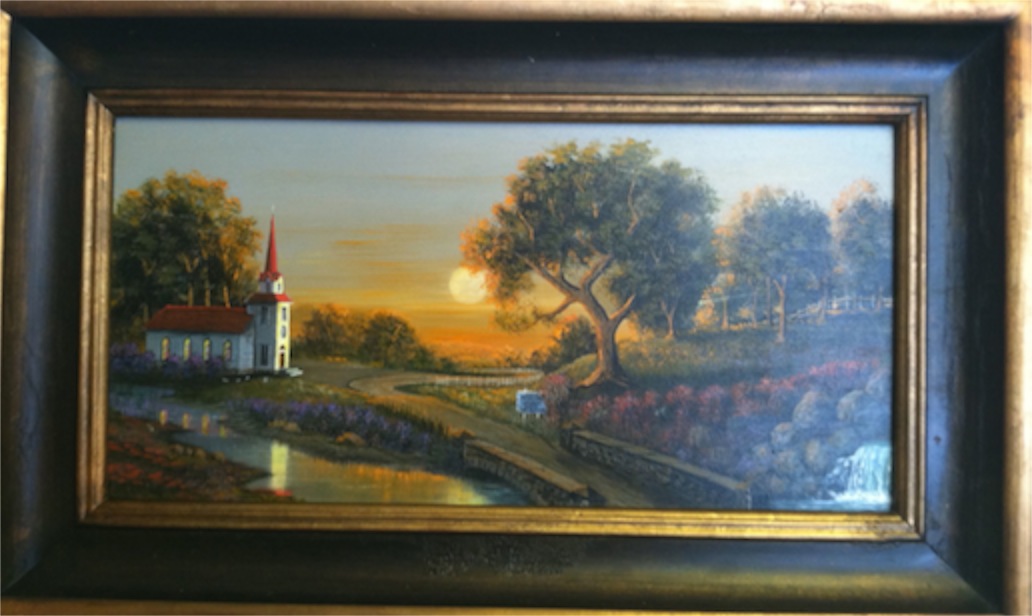
Along the way, we have heard of pastors who had hard times with their congregations. There are plenty of “horror stories” out there about problems in the relationship between pastor and congregation. Our experience, however, has been with healthy congregations who have treated their pastors well. We have been pleased to have found very good matches between our skills and the needs of the congregations we have served.
Still, I have, from time to time, looked at congregations in Montana. I have even been convinced that I was called to serve in my home state on several occasions. However, there is an important part of discerning a call that must be carefully considered. A call to serve in a particular location may manifest itself as a desire to have a particular job in a particular place. That desire, however, does not confirm that the call exists. Christians considering their call must check with others to discern if the call is really God’s work or a case of the “I wants.” The best way to check is to consult with others. In my case, there has never been a congregation who thought I was called to be their pastor when I thought that such a call existed.
I no longer have them, but for several years I kept letters from congregations in Montana informing me that they had found another pastor to serve them and that although they had been impressed by my credentials, I was not the right person at this time. While receiving those letters was a disappointment at the time, the process works very well. I have been blessed with wonderful congregations and have had a challenging and rewarding career as a pastor.
The thing about having thought about returning to Montana for so many years is that I have formed an idealized vision of my home state. When you don’t live with them and don’t have to deal with their issues on a daily basis, people seem to be very nice. When you aren’t shoveling the snow yourself, Montana blizzards seem quite tolerable. When you travel the roads only on vacation, the distances seem quite manageable. In a way, Montana has become my “Lake Woebegone.” It is a place that exists only in my imagination. This is not to say that Montana doesn’t exist, but rather that the way I imagine Montana to be is not the way it really is. I have an idealized vision in my mind.
If you are going to imagine a perfect place, it is nice to have it be in a neighboring state. Since graduating from seminary we have always lived in a state that shared a border with Montana.
I guess that I talk about Montana quite a bit. I know that I refer to my growing up and sometimes describe some aspects of my home town when I am preaching from time to time.
At any rate, a friend surprised me by presenting me with a painting he had done this Christmas. It is a lovely pastoral scene with a small country church. It is sunrise in the picture and the light warms and bathes everything. The man is a talented artist and the painting is beautiful. I was touched and overwhelmed at the thoughtfulness of the gift.
In the center of the painting is a small white sign. You have to get up really close to the painting to read the words on the sign, but they are there: “Little Montana Church, Ted Huffman pastor.” Somehow my imagination sparked the imagination of someone who is much more creative and artistically talented than I.
I have hung the painting over my desk at work. Whenever I need to, I can look up and catch a glimpse of a sunrise. And when I have a few moments, I can allow my imagination to wander back to Montana. The painting is not a reproduction of any particular church in any location, but rather the product of human imagination. It is not a specific church, but rather an imagined church that invites all to come in and experience the joy and fellowship of community.
Who knows, it is entirely possible that I will never again live in Montana. God has a way of surprising me with what comes next. I am beginning to approach the end of my career and I am in a very good place to live and work and serve God. But now, wherever I go and wherever I live, I will always have my little Montana church to remind me of my roots and inspire me to continue to serve in the places that God calls.

Along the way, we have heard of pastors who had hard times with their congregations. There are plenty of “horror stories” out there about problems in the relationship between pastor and congregation. Our experience, however, has been with healthy congregations who have treated their pastors well. We have been pleased to have found very good matches between our skills and the needs of the congregations we have served.
Still, I have, from time to time, looked at congregations in Montana. I have even been convinced that I was called to serve in my home state on several occasions. However, there is an important part of discerning a call that must be carefully considered. A call to serve in a particular location may manifest itself as a desire to have a particular job in a particular place. That desire, however, does not confirm that the call exists. Christians considering their call must check with others to discern if the call is really God’s work or a case of the “I wants.” The best way to check is to consult with others. In my case, there has never been a congregation who thought I was called to be their pastor when I thought that such a call existed.
I no longer have them, but for several years I kept letters from congregations in Montana informing me that they had found another pastor to serve them and that although they had been impressed by my credentials, I was not the right person at this time. While receiving those letters was a disappointment at the time, the process works very well. I have been blessed with wonderful congregations and have had a challenging and rewarding career as a pastor.
The thing about having thought about returning to Montana for so many years is that I have formed an idealized vision of my home state. When you don’t live with them and don’t have to deal with their issues on a daily basis, people seem to be very nice. When you aren’t shoveling the snow yourself, Montana blizzards seem quite tolerable. When you travel the roads only on vacation, the distances seem quite manageable. In a way, Montana has become my “Lake Woebegone.” It is a place that exists only in my imagination. This is not to say that Montana doesn’t exist, but rather that the way I imagine Montana to be is not the way it really is. I have an idealized vision in my mind.
If you are going to imagine a perfect place, it is nice to have it be in a neighboring state. Since graduating from seminary we have always lived in a state that shared a border with Montana.
I guess that I talk about Montana quite a bit. I know that I refer to my growing up and sometimes describe some aspects of my home town when I am preaching from time to time.
At any rate, a friend surprised me by presenting me with a painting he had done this Christmas. It is a lovely pastoral scene with a small country church. It is sunrise in the picture and the light warms and bathes everything. The man is a talented artist and the painting is beautiful. I was touched and overwhelmed at the thoughtfulness of the gift.
In the center of the painting is a small white sign. You have to get up really close to the painting to read the words on the sign, but they are there: “Little Montana Church, Ted Huffman pastor.” Somehow my imagination sparked the imagination of someone who is much more creative and artistically talented than I.
I have hung the painting over my desk at work. Whenever I need to, I can look up and catch a glimpse of a sunrise. And when I have a few moments, I can allow my imagination to wander back to Montana. The painting is not a reproduction of any particular church in any location, but rather the product of human imagination. It is not a specific church, but rather an imagined church that invites all to come in and experience the joy and fellowship of community.
Who knows, it is entirely possible that I will never again live in Montana. God has a way of surprising me with what comes next. I am beginning to approach the end of my career and I am in a very good place to live and work and serve God. But now, wherever I go and wherever I live, I will always have my little Montana church to remind me of my roots and inspire me to continue to serve in the places that God calls.
Copyright © 2011 by Ted Huffman. I wrote this. If you want to copy it, please ask for permission. thuffman53@mac.com. If you want to share it with a friend, please direct your friend to my web site.
Uncle Ted's Museum
27/12/11 05:18
Susan and I are now officially “empty nesters.” It took us a bit longer than some of our peers because we had my mother living with us after our children grew up and moved out of our home. But now we have the house to ourselves. In one sense it it bigger than we need. However, with the process of having helped parents close our their homes, it is filled with furniture and other items that need to be distributed. Still, the house is ours to fix up any way that we want.
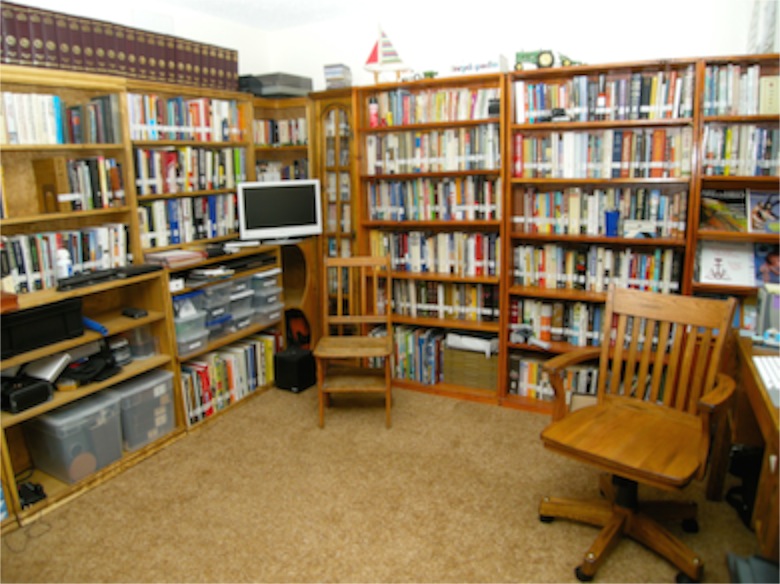
One of my projects has been to make myself a library. I have had a very nice office at work since I moved to Rapid City, but our home has been a bit short of a space for a study. In our first years in the house we used a small bedroom for a study. Later, the books were moved to the basement, then upstairs to another bedroom. But now I have a lovely room, with east-facing windows to greet the sunrise. It is the living room of what was designed to be a mother-in-law apartment at the daylight end of our basement. I started with some bookshelves that I had made when we lived in Boise and that have moved around this house. Then I started making more. I now have bookshelves on three walls of the room.
This fall, I brought home a library table that had belonged to our mother and had been in storage at my sister’s place in Oregon. The table has had an interesting life. It was purchased for the library at Rocky Mountain College, probably in the 1930’s. When the college built a new library in the early 1960’s, the furniture from the old library was distributed to dorm rooms. Subsequent constructions of new dorms and remodeling of old ones meant that a few of the library tables ended up in storage in the basement of a college building. When my parents put a new roofs on college buildings the lived in one of the old dorms and ended up purchasing the table to use in their living space. It is old and has been through a lot, but just right for the space.
We had an old library chair that unfolds into a small step stool that had been in Susan’s grandparents’ house and later in her parents’ home. It seems to fit right in my library. I put a mantle clock that has been in the family for four generations on one of the shelves and hung a somewhat newer clock on the wall.
The library is just right for my purposes.
Years ago, after my great uncle Ted passed away, mother collected some of his tools and inventions into a shed at the rear of her shop and dubbed the space “Uncle Ted’s Museum.” It was an interesting place to visit, with things that had been kept for sentimental reasons. There were several antique tools and other items. The idea was never fully developed, but the name hung around even after the space was used for other purposes.
As I looked around my new library, I realized that I had created an Uncle Ted’s Museum for a new generation. My great nieces and nephews and my grandchildren will marvel at the things I have here:
I have books, printed on paper, that you can pick up, hold in your hands and read. The children of today are growing up in a world a e-readers. Even when they have books, they are read and then passed on. The idea of keeping books to re-read and sometimes just to have to pull off the shelf for an occasional quote is quite outdated.
I have magazines, again, printed on paper. Yes, I have access to the digital database that contains all of the issues of the National Geographic Magazine, but I also have saved a few decades of the magazine, complete with indices to look up articles.
I have maps on paper. And an atlas with huge maps to study and dream over. Of course some of the political information on the map is now inaccurate, but for the most parts the names of cities in exotic places remain the same.
I have clocks with faces. Without a digital read-out, you have to know how to tell time for the clocks to be of any use. And they have to be wound. The mantle clock has to be wound every evening. The wall clock has to be wound once a week. They chime on the hours and one chimes every 15 minutes.
I have slides - real film with images on it. And I have a projector to show the slides.
Now I am not luddite. My library is filled with many state-of-the art items. As one who used to be the person to open the college library on early winter mornings, I think that a library should be dark at night. My library has no less than eight digital devices with glowing LEDs when I step into it. There are two printers, a large monitor, a slide scanner, and even a television set and a DVD player. Uncle Ted’s Museum has objects that younger members of the family will recognize, such as a computer. You can even use the computer to locate the books on the shelves.
But there is no game system. And, frankly, the television is used more to display images from the computer than it is to watch network programming. I don’t have cable TV in my home.
It is a very comfortable room for me and I feel fortunate to have such a space in my home. And others are always welcome to come into the room, though I don’t know whether or not they will find it to be as interesting as I do.
A blend of the old and new seems appropriate as we approach another new year’s holiday. We want to embrace the future with joy, but we don’t want to forget the past. We always stand in between the old and the new. It seems like a very comfortable place to be.

One of my projects has been to make myself a library. I have had a very nice office at work since I moved to Rapid City, but our home has been a bit short of a space for a study. In our first years in the house we used a small bedroom for a study. Later, the books were moved to the basement, then upstairs to another bedroom. But now I have a lovely room, with east-facing windows to greet the sunrise. It is the living room of what was designed to be a mother-in-law apartment at the daylight end of our basement. I started with some bookshelves that I had made when we lived in Boise and that have moved around this house. Then I started making more. I now have bookshelves on three walls of the room.
This fall, I brought home a library table that had belonged to our mother and had been in storage at my sister’s place in Oregon. The table has had an interesting life. It was purchased for the library at Rocky Mountain College, probably in the 1930’s. When the college built a new library in the early 1960’s, the furniture from the old library was distributed to dorm rooms. Subsequent constructions of new dorms and remodeling of old ones meant that a few of the library tables ended up in storage in the basement of a college building. When my parents put a new roofs on college buildings the lived in one of the old dorms and ended up purchasing the table to use in their living space. It is old and has been through a lot, but just right for the space.
We had an old library chair that unfolds into a small step stool that had been in Susan’s grandparents’ house and later in her parents’ home. It seems to fit right in my library. I put a mantle clock that has been in the family for four generations on one of the shelves and hung a somewhat newer clock on the wall.
The library is just right for my purposes.
Years ago, after my great uncle Ted passed away, mother collected some of his tools and inventions into a shed at the rear of her shop and dubbed the space “Uncle Ted’s Museum.” It was an interesting place to visit, with things that had been kept for sentimental reasons. There were several antique tools and other items. The idea was never fully developed, but the name hung around even after the space was used for other purposes.
As I looked around my new library, I realized that I had created an Uncle Ted’s Museum for a new generation. My great nieces and nephews and my grandchildren will marvel at the things I have here:
I have books, printed on paper, that you can pick up, hold in your hands and read. The children of today are growing up in a world a e-readers. Even when they have books, they are read and then passed on. The idea of keeping books to re-read and sometimes just to have to pull off the shelf for an occasional quote is quite outdated.
I have magazines, again, printed on paper. Yes, I have access to the digital database that contains all of the issues of the National Geographic Magazine, but I also have saved a few decades of the magazine, complete with indices to look up articles.
I have maps on paper. And an atlas with huge maps to study and dream over. Of course some of the political information on the map is now inaccurate, but for the most parts the names of cities in exotic places remain the same.
I have clocks with faces. Without a digital read-out, you have to know how to tell time for the clocks to be of any use. And they have to be wound. The mantle clock has to be wound every evening. The wall clock has to be wound once a week. They chime on the hours and one chimes every 15 minutes.
I have slides - real film with images on it. And I have a projector to show the slides.
Now I am not luddite. My library is filled with many state-of-the art items. As one who used to be the person to open the college library on early winter mornings, I think that a library should be dark at night. My library has no less than eight digital devices with glowing LEDs when I step into it. There are two printers, a large monitor, a slide scanner, and even a television set and a DVD player. Uncle Ted’s Museum has objects that younger members of the family will recognize, such as a computer. You can even use the computer to locate the books on the shelves.
But there is no game system. And, frankly, the television is used more to display images from the computer than it is to watch network programming. I don’t have cable TV in my home.
It is a very comfortable room for me and I feel fortunate to have such a space in my home. And others are always welcome to come into the room, though I don’t know whether or not they will find it to be as interesting as I do.
A blend of the old and new seems appropriate as we approach another new year’s holiday. We want to embrace the future with joy, but we don’t want to forget the past. We always stand in between the old and the new. It seems like a very comfortable place to be.